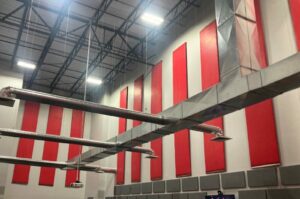Acoustic panels are used to reduce background noise in large rooms by absorbing sound energy, thereby minimizing echoes, reverberation, and overall noise levels. Here’s how they work and are used:
- Absorption of Sound Waves: Acoustic panels are designed to absorb sound waves that would otherwise bounce off hard surfaces. They are typically made of materials with high sound absorption properties, such as fiberglass and foam, which may or may not be wrapped in acoustically transparent fabric,
- Installation on Walls and Ceilings: The sound panels are strategically placed on walls and ceilings in a room. The goal is to cover surfaces that would otherwise reflect sound, creating a more acoustically balanced environment. The exact placement/location of the panels isn’t as critical as ensuring you avoid under-treating the space. You’ll achieve the best results by evenly distributing the panels throughout the room. Take advantage of our Free Room Analysis to get help with determining the correct coverage amounts for your space.
- Reducing Echoes and Reverberation: In large rooms with hard surfaces, sound can bounce around and create echoes. Acoustic panels absorb these sound waves, preventing them from bouncing and reducing echoes. This is particularly important in auditoriums, conference rooms, theaters, and other large spaces where clear communication is essential.
- Improving Speech Intelligibility: By reducing background noise and echoes, acoustic panels enhance speech intelligibility. This is crucial in spaces where effective communication is necessary, such as classrooms, meeting rooms, and lecture halls.
- Enhancing Audio Quality: In spaces designed for music, recording, or audio production, acoustic panels help create a controlled and acoustically pleasing environment. They contribute to better sound quality by minimizing unwanted reflections and maintaining a more balanced acoustic response.
- Customization for Specific Frequencies: Acoustic panels can be designed to target specific frequencies. This allows for customization based on the types of sounds present in a particular environment. Bass traps, for example, are specialized panels that focus on low-frequency absorption.
- Aesthetics and Design: Acoustic panels come in various shapes, sizes, and designs. This allows for both functional and aesthetic considerations. Some panels are designed to blend seamlessly with the decor of a room while still effectively reducing background noise, such as NetWell’s PicturePanels.

CASE STUDY
NetWell Noise Control was recently contacted by a well-known power tool company that had an echo problem inside a large meeting space within one of their buildings. The room was extremely tall and had various fixtures hanging from the ceiling, which made a ceiling-suspended application not feasible. Our popular Fabric Panels can only be made up to a maximum of 4′ x 10′, and they had a LOT of wall space to cover. Their A/V integrator, CTI, decided to hang NetWell’s acoustic Tapestry panels on the walls. By covering the walls with large sound-absorbing Tapestry panels, they were able to effectively reduce the reverberation and echo in the room while meeting their client’s budget requirements.
Have questions? Our knowledgeable team of acoustical consultants can be reached at
1-800-638-9355 or by email at help@controlnoise.com